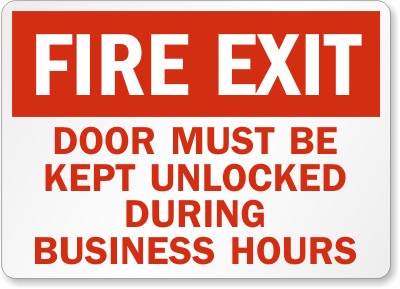OSHA calls for improvements in retail employee safety
As retail customers, we’re used to being greeted by well-lit, clean and clear walkways. But that neat façade might be concealing a potentially deadly hazard, and several agencies with the Occupational Safety and Health Administration are launching campaigns to improve retail employee safety.
Over the last three years, “blocked egress” – exit routes or doors that are locked or blocked – was the most common violation cited in inspections of department stores, according to OSHA. In addition to having an adequate number of exits, employers must maintain a “protected way of travel” from any location in the workplace so that employees can safely evacuate during an emergency such as a fire.
Failure to do so is considered a “serious” violation, with “substantial probability that death or serious physical harm could result from the hazard about which the employer knew or should have known.”
While the topic of clearly marked and unabated exits typically only comes up once a year, preceding the Black Friday crowds, it is often a repeat problem.
In April, a Burlington Coat Factory in Lancaster, PA, received a $22,000 fine after an OSHA inspection revealed “multiple restricted means of egress”–the same violation the store received in 2010. And in February, a Forever 21 store in Massachusetts was hit with a $55,000 fine for multiple repeat violations, including an emergency exit route narrowed by storage boxes. This wasn’t the first time that the teen-focused apparel chain faced the citation. In April 2012, a Forever 21 in New Jersey received a repeat egress violation carrying a $25,000 penalty (compared to a fine of around $1,000 for a first-time penalty).
As is all too common with workplace hazards, it usually takes a tragedy–rather than repeat citations–to bring about real change.
In June the OSHA Directorate of Enforcement ordered that all inspections of all workplaces include an assessment of exit routes. According to a Bloomberg report, the decision was made following the deaths of 119 workers in a Chinese poultry processing plant, where exit doors were reportedly blocked or locked.
On a regional level, an OSHA office in Philadelphia is taking a proactive route to ensure retail employee safety in department stores. Throughout the busy summer and fall seasons, when department stores have the largest inventory, and usually the greatest number of workers, OSHA inspectors will visit stores with more than 10 employees to check if the store is complying with the agency’s rules for exits as well as merchandise storage.
Despite the limited geographic scope of the project, the office hopes it will have a large ripple effect. In a notice issued on the program, the office states: “Since it is likely many of the stores inspected under this LEP (Local Emphasis Program) are part of national chains, it is hoped that enforcement action in one store will have a have significant national impact.”

Store exits must be clear from storage boxes and remain unlocked at all times.
Category: OSHA












